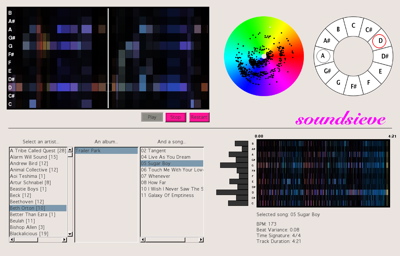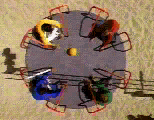soundsieve [v1.0]
Here’s a screenshot from the thing I’ve been working on for most of the past week:

I was getting it ready to show sponsors this week at the Media Lab. People responded really well, and it was lots of fun talking to people and hearing what they had to say. I already have a long list of things I want to do with it over the summer (starting with making it an iTunes plugin).
Here’s some text from the handout:
soundsieve is a music visualizer that takes the intrinsic qualities of a musical piece – pitch, time, and timbre – and makes their patterns readily apparent in a visual manner. For example, you can quickly pick out repeating themes, chords, and complexity from the pictures and video.
It’s a new, informative way to look at your music. It allows you to explore the audio structure of any song, and will be a new way to interact with your whole music library, enabling you to navigate the entire space of musical sound.
The current form of soundsieve is a music browser (like iTunes), that lets you see visual representations of any MP3 you own. You select a song, and see a set of pictures of the piece’s audio structure. Then you can choose to play the song, and see real-time visualizations accompanying the piece.
I posted some early documentation on the project, but I’ll have to go through and update it soon.
Hedy Lamarr and frequency hopping
 We’ve been learning about radio frequency transmission in sensors class, and today Ari told us about how actress Hedy Lamarr and composer George Antheil came up with the idea of frequency hopping to avoid jamming of radio-controlled torpedoes during WWII. The best part was their idea to use a roll from a player piano, on both the torpedo and transmitter, to change the transmission frequencies. I had fun looking at their patent here.
We’ve been learning about radio frequency transmission in sensors class, and today Ari told us about how actress Hedy Lamarr and composer George Antheil came up with the idea of frequency hopping to avoid jamming of radio-controlled torpedoes during WWII. The best part was their idea to use a roll from a player piano, on both the torpedo and transmitter, to change the transmission frequencies. I had fun looking at their patent here.
From http://hypatiamaze.org/h_lamarr/scigrrl.html:
Hedy knew that “guided” torpedos were much more effective hitting a target, a ship at sea for example. The problem was that radio-controlled torpedos could easily be jammed by the enemy. Neither she nor Antheil were scientists, but one afternoon she realized “we’re talking and changing frequencies” all the time. At that moment, the concept of frequency-hopping was born.
Antheil gave Lamarr most of the credit, but he supplied the player piano technique. Using a modified piano roll in both the torpedo and the transmitter, the changing frequencies would always be in synch. A constantly changing frequency cannot be jammed.
They offered their patented device to the U.S. military then at war with Germany and Japan. Their only goal was to stop the Nazis. Unfortunately or predictably, the military establishment did not take them or their novel invention seriously. Their device was never put to use during World War II.
From http://en.wikipedia.org/wiki/Hedy_Lamarr#Frequency-hopped_spread_spectrum_invention:
Lamarr’s frequency-hopping idea served as the basis for modern spread-spectrum communication technology used in devices ranging from cordless telephones to WiFi Internet connections.
Lamarr was awarded by the EFF in 1997 for her contributions to this invention.
The mysterious Coriolis force
 I remember the term “Coriolis force” from some ancient high school physics class, I think. But when Joe P showed us this phenomenon again in class last week, I could swear I’ve never ever thought about it before. It’s a little baffling to me at the moment (and therefore worth thinking about!).
I remember the term “Coriolis force” from some ancient high school physics class, I think. But when Joe P showed us this phenomenon again in class last week, I could swear I’ve never ever thought about it before. It’s a little baffling to me at the moment (and therefore worth thinking about!).
Compare the simple video on the Coriolis force Wikipedia page with the merry-go-round video on this page. Now figure out how cyclone winds rotate along the Earth’s surface… and you’re all set!
Marvin Minsky
 Last night, I went to see Marvin Minsky talk in the Media Lab auditorium, specifically about his contributions to Stanley Kubrick‘s 2001: A Space Odyssey, on his new book (The Emotion Machine), and all sorts of other things.
Last night, I went to see Marvin Minsky talk in the Media Lab auditorium, specifically about his contributions to Stanley Kubrick‘s 2001: A Space Odyssey, on his new book (The Emotion Machine), and all sorts of other things.
Highlights from the talk (with minimal paraphrasing, hopefully):
- “I’ll give a better talk if the computer breaks, because I have an outline here… and… It’s very hard to follow an outline if you get a new idea.”
- “I like to make lists of disasters.”
- “[Kubrick] tried to get me to play chess but I wouldn’t.”
- [on NASA] “… and now they’re thinking of sending people to Mars which is crazy because they’ll be DEAD.”
- Minsky referring to his laser pointer as “the death ray”
- “[The estimate came from] me thinking of the 20-30 ways to estimate the number [of simple statements a 10- or 15-year-old child knows], and then diddling it until they all came out the same.”
- “But you know that most people have 4 or 5 emotions, like hunger and fear, and uh… whatever.”
- Marvin Minsky loves LISP.
- He uses a Mac and did his presentation by scrolling through many pages of a PDF.
- In response to this question: “If AI becomes as good as you’re describing… how should we treat these new machines ethically? Should we treat them like humans?”
Minsky: “If it was as smart as a person, it would very soon become much smarter, so you could ask it!”
If you’re interested in the movie stuff in particular, here’s a pretty good interview with Marvin Minsky, on working briefly with Kubrick.
If you want to get an idea of how Minsky talks about his ideas, here’s a nice transcript of a presentation Minsky made at the Game Developers Conference in 2001.
In school when they teach you about thinking or learning…and what’s school for? It’s not to learn about Inuit culture or Egyptian culture or algebra or geography or whatever? What you’re really in school for is to learn about thinking and learning.
Here is Marvin Minsky’s Wikipedia entry, notable to me at this moment because it has an active notation by Marvin himself in the “Trivia” section.
Talking Mylar balloons
The topic today in sensors class was piezoelectric sensors. Joe P showed us a wonderful application for them: as both a microphone and speaker in a Mylar balloon.
The Responsive Environments Group has a page on the project:
Interactive Balloons
There is a great video on that page: Joe talking to a balloon, and then two balloons talking to each other.
Using an oscilloscope
By far the best thing I learned today was from watching Mark Feldmeier show me how to get my scope to do what I want. I’ve been twiddling knobs on these things for months now, and for some reason only just learned how to get the scope to:
- measure the frequency of a signal
- measure the voltage (peak-to-peak or avg or rms) of a signal
- limit high-frequency noise on a signal
I had always thought that turning the dials on the scope just changed the display parameters, but Mark told me that it actually affects the accuracy of the readings, since you are indeed adjusting gains inside the scope itself! The lesson: If you want to measure values from your signal, make the signal as big as you can on the screen.
I also learned what a Butterworth response is, yeehaw!
Giving demos
I led two different groups from the Computer Clubhouse through my group‘s space today.
Things I hope to remember for next time:
- Find out who your audience is
- Ask questions
- Prioritize. What would they care about?
- Improvise
- Talk like normal
- Don’t think too much
- Encourage feedback
And, some general advice for self:
Don’t forget to eat.
“The One-Minute” (March 1, addendum)
This afternoon at the Media Lab, we had the poster session for the Masters students graduating this year. The lower atrium of the Lab is set up with big foamcore panels, and everyone comes down, puts up their poster, and hovers nearby. I went by about halfway through to see what people are up to with their work these days. While wandering around, I passed Director Frank Moss several times — he was perusing the posters and chatting up the hoverers, of course. And when he walked up to Nick, he said, “Alright, gimme your one-minute.”
<deep breath> Man, what would I say in one minute about my work?
Giving a “one-minute” is one of those things that we learn hard here at the Lab. And it’s something I definitely need some good hard practice at.
